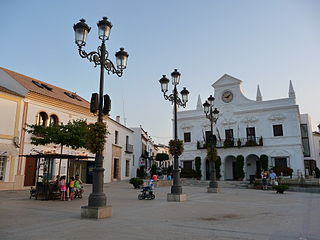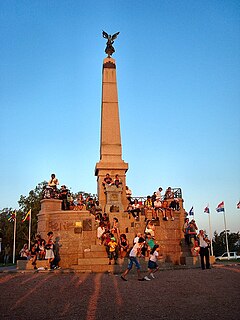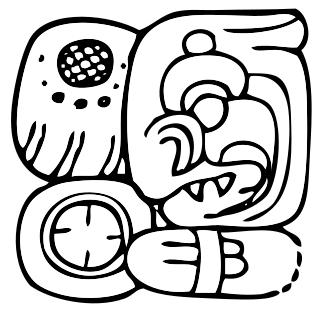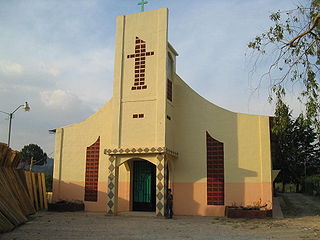
Piedras Negras is the modern name for a ruined city of the pre-Columbian Maya civilization located on the north bank of the Usumacinta River in the Petén department of northeastern Guatemala. Piedras Negras is one of the most powerful of the Usumacinta ancient Maya urban centers. Occupation at Piedras Negras is known from the Late Preclassic period onward, based on dates retrieved from epigraphic information found on multiple stelae and altars at the site. Piedras Negras is an archaeological site known for its large sculptural output when compared to other ancient Maya sites. The wealth of sculpture, in conjunction with the precise chronological information associated with the lives of elites of Piedras Negras, has allowed archaeologists to reconstruct the political history of the Piedras Negras polity and its geopolitical footprint.

Piedras Negras is a city and seat of the surrounding municipality of the same name in the Mexican state of Coahuila. It stands at the northeastern edge of Coahuila on the U.S.-Mexico border, across the Rio Grande from Eagle Pass in the U.S. state of Texas. In the 2015 census the city had a population of 163,595 inhabitants, while the metropolitan area had a population of 245,155 inhabitants. The Piedras Negras and the Eagle Pass areas are connected by the Eagle Pass-Piedras Negras International Bridge, Camino Real International Bridge, and the Eagle Pass Union Pacific International Railroad Bridge.

Guantánamo is a municipality and city in southeast Cuba and capital of Guantánamo Province.

Las Piedras is a municipality in east Puerto Rico (U.S.) located in the center region of the island, north of Yabucoa; south of Canóvanas and Río Grande; east of Juncos and San Lorenzo; and west of Naguabo and Humacao. Las Piedras is spread over 7 wards and Las Piedras Pueblo. It is part of the San Juan-Caguas-Guaynabo Metropolitan Statistical Area.

Piedras Negras International Airport is an international airport located at Piedras Negras, Coahuila, Mexico, near the U.S.-Mexico border. It handles national air traffic for the bi-national metropolitan zone Piedras Negras–Eagle Pass, Texas.

Río Piedras is a former municipality of Puerto Rico, which was consolidated with the municipality of San Juan, Puerto Rico in 1951. It was founded in 1714, and has been the home of the University of Puerto Rico's main campus since 1903, earning the popular name of Ciudad Universitaria.

Cartaya is a Spanish locality and municipality in the Province of Huelva. In 2010 had 18,415 inhabitants. Its surface area is 226.4 km² and has a density of 81.34 people per km².

Las Piedras is a city in the Canelones Department of Uruguay. As of the census of 2011, it is the fifth most populated city of the country.
Piedra Volada Falls is a 366-meter tall plunge waterfall in the Barranca Candameña of the Sierra Madre Occidental range in Chihuahua, Mexico.

Zipacón is a municipality and town of Colombia in the Western Savanna Province, part of the department of Cundinamarca. The urban centre of Zipacón is situated at an altitude of 2,550 metres (8,370 ft) on the Bogotá savanna, the southern flatlands of the Altiplano Cundiboyacense in the Eastern Ranges of the Colombian Andes. Zipacón borders Anolaima, Facatativá, La Mesa and Bojacá.

Monasterio de Piedra is a monastery, hotel and park complex in the Iberian System mountain ranges, near Nuévalos, province of Zaragoza, Aragon, Spain. The monastery was founded in 1194 by Alfonso II of Aragon, with thirteen Cistercian monks from Poblet Monastery, in an old castle next to the Piedra River, and was dedicated to St. Mary the White. On February 16, 1983, the entire complex was declared a national monument.

Las Piedras is a suburb of Bella Unión in the Artigas Department of northern Uruguay.

Luvianos is a small town and municipality located in the southwest of the State of Mexico. It gained municipal status in 2000. People can access Luvianos by driving Federal Road 134 south from Toluca, and then take a detour about 25 minutes north of Tejupilco. The name is derived from a hacienda what was established during colonial times.

The Stone of El Peñol, or simply La Piedra or El Peñol, is a landmark inselberg also known as The Rock of Guatapé, in Colombia. It is located in the town and municipality of Guatapé, Antioquia. The town of El Peñol, which borders Guatapé, has also historically claimed the rock as their own and thus the monolith is sometimes referred to as the "Stone of El Peñol" instead of the "Rock of Guatapé".

Piedra is an unincorporated community in Fresno County, California. It is located on the south bank of the Kings River 23 miles (37 km) east of Fresno, at an elevation of 538 feet.

Haʼ Kʼin Xook, also known as Ruler 6, was an ajaw of Piedras Negras, an ancient Maya settlement in Guatemala. He ruled during the Late Classic Period, from 767–780 AD. Haʼ Kʼin Xook was a son of Itzam Kʼan Ahk II, and he ascended the throne following the death of his brother, Yoʼnal Ahk III. Haʼ Kʼin Xook's reign ended with either his death or his abdication in favor of his brother Kʼinich Yat Ahk II; archaeologists and Mayanists have not arrived at a clear consensus. Haʼ Kʼin Xook left behind several monuments, including stelae at Piedras Negras and a stone fragment from El Porvenir. In addition, a stone seat known as Throne 1 and erected by Kʼinich Yat Ahk II records either the death or abdication of Haʼ Kʼin Xook.

Kʼinich Yat Ahk II, also known as Ruler 7, was the last ajaw of Piedras Negras, an ancient Maya settlement in Guatemala. He ruled during the Late Classic Period, from 781 to roughly 808 AD. Possibly a descendant of Itzam Kʼan Ahk II, Kʼinich Yat Ahk II ascended the throne upon the death of his brother, the sixth ajaw of the site, Haʼ Kʼin Xook. While Kʼinich Yat Ahk II presided over the destruction of the rival Maya site Pomona, his reign likely ended with Kʼinich Tatbu Skull IV of Yaxchilan capturing and subjugating Piedras Negras. Itzam Kʼan Ahk II left behind several monuments, including stelae at Piedras Negras, a stone seat known as Throne 1 which records either the death or abdication of Haʼ Kʼin Xook, and Panel 3 which recounts the exploits of Itzam Kʼan Ahk II.

La Mar, also known by its Maya name Rabbit Stone, is the modern name for a ruined city of the pre-Columbian Maya civilization located in the state of Chiapas in Mexico. During the 8th century AD, it was an ally of the nearby center Piedras Negras. Stela 12 at Piedras Negras, identifies one of the kings of La Mar as being named Parrot Chaak.
El Porvenir is the modern name for a ruined city of the pre-Columbian Maya civilization located in the Petén department of Guatemala. Ron Canter, in his paper "The Usumacinta River Portages in the Maya Classical Period" argues that El Porvenir was the first point at which the ancient Maya portaged to avoid the unnavigable portions of the Usumacinta River. A fragment of stone found at the site and aptly called the "El Porvenir Fragment" was also discovered that bore the name of Ha' K'in Xook, the sixth ajaw of Piedras Negras, suggesting a connection to the site.

The Martyrs of Christ the King Cathedral Also Piedras Negras Cathedral Is a Catholic temple that serves as the cathedral of the city of Piedras Negras to the northeast of the state of Coahuila in Mexico, near the border with the Texan city of Eagle Pass. Located inside the Technological Residential, it is one of the modern jewels from the city.





















